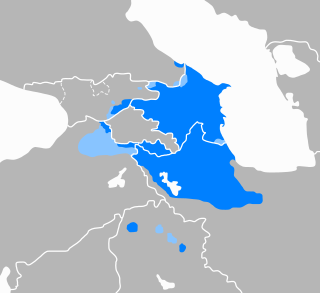
Back Азербаиџьан бызшәа Abkhazian Bahsa Azèrbaijan ACE Azerbeidjans Afrikaans አዘርኛ Amharic Azerisc sprǣc ANG अजरबैजान भाषा ANP اللغة الأذرية Arabic لأزيربيدجانية ARY اذرى ARZ Idioma azerbaixanu AST
| Azerbaijani | |
|---|---|
| Azeri | |
| Azərbaycan dili, آذربایجان دیلی, Азәрбајҹан дили[note 1] | |
 Azerbaijani in Perso-Arabic Nastaliq (Iran), Latin (Azerbaijan), and Cyrillic (Russia). | |
| Pronunciation | [ɑːzæɾbɑjˈdʒɑn diˈli] |
| Native to |
|
| Region | Iranian Azerbaijan, South Caucasus |
| Ethnicity | Azerbaijanis |
Native speakers | 24 million (2022)[2] |
Turkic
| |
Early forms | |
Standard forms | |
| Dialects | |
| |
| Official status | |
Official language in | Azerbaijan Dagestan (Russia) Organization of Turkic States |
| Regulated by |
|
| Language codes | |
| ISO 639-1 | az |
| ISO 639-2 | aze |
| ISO 639-3 | aze – inclusive codeIndividual codes: azj – North Azerbaijaniazb – South Azerbaijani |
| Glottolog | azer1255 Central Oghuz |
| Linguasphere | part of 44-AAB-a |
 Areas that speak Azerbaijani The majority speak Azerbaijani A sizable minority speaks Azerbaijani | |
| Part of a series on |
| Azerbaijanis |
|---|
| Culture |
| Traditional areas of settlement |
| Diaspora |
| Religion |
| Language |
| Persecution |
Azerbaijani (/ˌæzərbaɪˈdʒæni, -ɑːni/ AZ-ər-by-JAN-ee) or Azeri (/æˈzɛəri, ɑː-, ə-/ az-AIR-ee, ah-, ə-), also referred to as Azeri Turkic or Azeri Turkish, is a Turkic language from the Oghuz sub-branch. It is spoken primarily by the Azerbaijani people, who live mainly in the Republic of Azerbaijan, where the North Azerbaijani variety is spoken, while Iranian Azerbaijanis in the Azerbaijan region of Iran, speak the South Azerbaijani variety. Azerbaijani has official status in the Republic of Azerbaijan and Dagestan (a federal subject of Russia), but it does not have official status in Iran, where the majority of Iranian Azerbaijani people live. Azerbaijani is also spoken to lesser varying degrees in Azerbaijani communities of Georgia and Turkey and by diaspora communities, primarily in Europe and North America.
Although there is a high degree of mutual intelligibility between both forms of Azerbaijani, there are significant differences in phonology, lexicon, morphology, syntax, and sources of loanwords. The standardized form of North Azerbaijani (spoken in the Republic of Azerbaijan and Russia) is based on the Shirvani dialect, while South Azerbaijani uses a variety of regional dialects. Since the Republic of Azerbaijan's independence from the Soviet Union in 1991, Northern Azerbaijani has used the Latin script. On the other hand, South Azerbaijani has always used and continues to use the Perso-Arabic script.
Azerbaijani is closely related to Turkmen, Turkish, Gagauz, and Qashqai, being mutually intelligible with each of these languages to varying degrees.
Cite error: There are <ref group=note> tags on this page, but the references will not show without a {{reflist|group=note}} template (see the help page).
- ^ Bulut, Christiane (2018b). "The Turkic varieties of Iran". In Haig, Geoffrey; Khan, Geoffrey (eds.). The Languages and Linguistics of Western Asia: An Areal Perspective. Walter de Gruyter. p. 398. ISBN 978-3-11-042168-2.
- ^ Azerbaijani language at Ethnologue (25th ed., 2022)

- ^ a b "Azerbaijani, North". Ethnologue. Archived from the original on 5 June 2019. Retrieved 2 February 2020.
- ^ Cite error: The named reference
Ethnologue 22 AZBwas invoked but never defined (see the help page). - ^ Cite error: The named reference
:0was invoked but never defined (see the help page).
Cite error: There are <ref group=lower-alpha> tags or {{efn}} templates on this page, but the references will not show without a {{reflist|group=lower-alpha}} template or {{notelist}} template (see the help page).